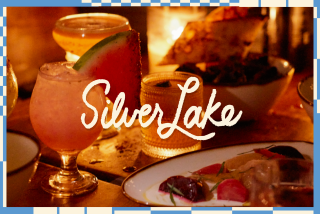Crackers, fish eggs--all part of new Key West : Island’s becoming a chic and pricey resort. But many wonder whether it’s losing its funky soul.
- Share via
KEY WEST, Fla. — This is the city at the end of the road, the southernmost spot in the continental United States, the last island in an archipelago that dangles off the Florida mainland like beads on an aquamarine strand.
The remoteness has suited it well, for Key West has always been something of a rogue’s paradise, even through a sequence of identity changes: fishing village, artists’ colony, naval base, marijuana port, raucous tourist town.
These days, the city is busy changing identities again, this time toward a chic and pricey resort, and many here worry that their free-spirited island is finding its fortune only to lose its funky soul.
Condos and hotels are rising up to take the best view of the waterfront, and Duval Street, the heart of the city, is increasingly the home of trendy boutiques and restaurants. Homes routinely sell for $500,000 and up.
“The island’s full of high caliber, hoi polloi types--you know, eating crackers with fish eggs on them and all that crap,” says Tony Tarracino, once the city’s best-known saloon keeper and now its newly elected mayor.
“Big Money,” Tarracino says, threatens to turn the island into the one thing it has never been before: dull.
In the 1970s, when Key West first began courting tourists seriously, it offered a freewheeling, anything-goes vitality that welcomed the outrageous.
This was the Margaritaville of the Jimmy Buffett song, where people walked in flip-flops, “wasting away again.” A reckless attitude wafted in the breeze: bawdy, laid back, independent, a little soused.
But with that attitude also came scruffiness--noise and litter and street hustling. This was not entirely compatible with $200 a night hotel rooms, and, inevitably, city big shots wanted to strap on some restraints.
In the present climb toward upscale, Key West regulates street vendors and street performers. In the last few weeks, it has also put a muzzle on the late-night rock ‘n’ roll that customarily blares from popular open-air bars.
The new noise ordinance bans any sound after 10 p.m. that can be heard 150 feet from its source, a move that has silenced many of the city’s live bands. “They’re rolling up the carpet at 10 p.m. to make the streets safe for their Mercedeses and Rolls Royces,” complains Mark Rossi, who owns Rick’s Bar.
Like many others, Rossi blames the quieting of Key West on the one man who has come to symbolize Big Money here, the 37-year-old, turban-wearing developer Pritam Singh.
Back in 1971, when Singh was a hippie named Paul LaBombard Jr., he wandered here and stayed for four adventuresome months. He says he dove for conch shells that he then sold to tourists.
Soon after, his vagabond life led him to a Sikh ashram in Massachusetts, where he adopted a new set of religious beliefs and a new name to go with them.
Now he has returned to Key West as a multimillionaire businessman. In 1986, he paid $17.2 million for 103 acres of prime land, the former U.S. naval base that sits not far from the busiest part of Duval Street. He plans to build homes, condos, shops, a marina and a Ritz-Carlton Hotel.
To a bar owner like Rossi, this new development is frighteningly tasteful and refined--and the anti-noise Singh is “a rich jerk who’s trying to sell $500,000 houses 2 blocks from an open-air bar district. I mean, c’mon, that’s like building them next to an airport.”
But to the developer, as well as many others who own some of the city’s charming and ornate wooden homes, the time has simply come for “certain people to stop being rude while others are trying to sleep.”
After all, Singh argues, the most authentic Key West is not necessarily the recent and boisterous one; rather, it is the island of the late 19th Century, when the city was actually the wealthiest in early Florida.
“This is traditionally a place of money . . . “ says the high-toned Singh, who can make a real estate deal sound like a humanist crusade. “Tourism is sharing a nice place with others, and that’s an enlightening thing to do.”
There is already plenty of sharing going on. Each day, 50 commercial flights set down on this slender finger of land, 2 miles by 4. Some 1.5 million tourists visited last year alone.
They may not discover the gritty island they expected, where fishermen came off the trawlers at sundown. But there are plenty of galleries with expensive maritime paintings and lithographs that look real enough.
And they may not find zany Margaritaville, but they can buy a comfortable T-shirt at the Jimmy Buffett Margaritaville store and “waste away again” at the adjoining Margaritaville restaurant.
More to Read
Sign up for The Wild
We’ll help you find the best places to hike, bike and run, as well as the perfect silent spots for meditation and yoga.
You may occasionally receive promotional content from the Los Angeles Times.






